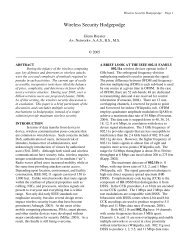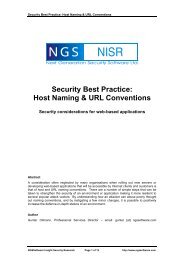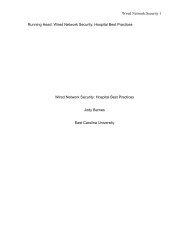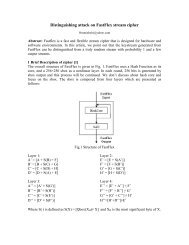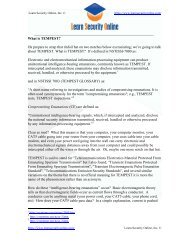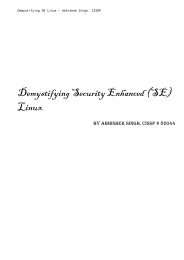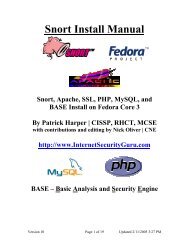Encapsulating Security Payload: Strengths and Weaknesses
Encapsulating Security Payload: Strengths and Weaknesses
Encapsulating Security Payload: Strengths and Weaknesses
You also want an ePaper? Increase the reach of your titles
YUMPU automatically turns print PDFs into web optimized ePapers that Google loves.
<strong>Encapsulating</strong> <strong>Security</strong> <strong>Payload</strong>:<br />
<strong>Strengths</strong> <strong>and</strong> <strong>Weaknesses</strong><br />
Shawn W. Toderick<br />
DTEC 6823<br />
East Carolina University<br />
July 23, 2004
1<br />
INTRODUCTION<br />
IP <strong>Security</strong> is a large <strong>and</strong> complicated specification that has many options<br />
<strong>and</strong> is very flexible. The <strong>Encapsulating</strong> <strong>Security</strong> <strong>Payload</strong> protocol can h<strong>and</strong>le all<br />
of the services IPsec requires. This paper will attempt to discuss the<br />
<strong>Encapsulating</strong> <strong>Security</strong> <strong>Payload</strong> (ESP) protocol – a comparison with<br />
Authentication Header, <strong>and</strong> ESP weaknesses <strong>and</strong> strengths.<br />
OVERVIEW OF IPSEC<br />
In November 1998, the RFCs for IP <strong>Security</strong> (IPsec) were released – RFC<br />
2401 through RFC 2411. As specified in RFC 2401 [1], IPsec provides security<br />
services at the IP layer by enabling a system to select required parameters, such<br />
as security protocols, security algorithms for the services, <strong>and</strong> any cryptographic<br />
keys the service requires.<br />
IP-level security services cover authentication, confidentiality, <strong>and</strong> key<br />
management. Authentication verifies the sender <strong>and</strong> that the packet has not<br />
been altered, confidentiality provides encryption, <strong>and</strong> key management<br />
addresses the secure exchange of keys.<br />
IPsec call for two security protocols – Authentication Header (AH) which<br />
provides authentication, <strong>and</strong> <strong>Encapsulating</strong> <strong>Security</strong> <strong>Payload</strong> (ESP) which<br />
provides authentication, encryption, or both. IPsec also has two modes of<br />
operation: transport mode <strong>and</strong> tunnel mode.<br />
Ferguson <strong>and</strong> Schneier [2] address the complexity that the combination of<br />
the two protocols <strong>and</strong> two modes create. Ferguson <strong>and</strong> Schneier discuss the
2<br />
complexity of IPsec <strong>and</strong> its components, which is outside the scope of this paper.<br />
It should be noted though, that they recommend the elimination of transport<br />
mode (which they believe to be a subset of tunnel mode) <strong>and</strong> AH (due to the<br />
elimination of transport mode) without the loss of any functionality.<br />
AH AND ESP COMPARISON<br />
This comparison between the AH protocol <strong>and</strong> the ESP protocol<br />
encompasses IPv4 implementations only.<br />
AH, defined in RFC 2402 [3] provides support for data integrity <strong>and</strong><br />
authentication of IP packets. AH provides authentication of the payload <strong>and</strong> the<br />
packet header <strong>and</strong> protects against replays with the use of sequence numbers,<br />
but does not provide confidentiality (encryption).<br />
ESP, defined in RFC 2406 [4], provides confidentiality, data origin<br />
authentication, connectionless integrity, an anti-replay service (a form of partial<br />
sequence integrity), <strong>and</strong> limited traffic flow confidentiality. ESP authentication is<br />
provided by the combination of the data origin authentication <strong>and</strong> connectionless<br />
integrity services, which are optional. Anti-replay, also optional, may only be<br />
used if data origin authentication is employed.<br />
The main difference between AH <strong>and</strong> ESP is the extent of the coverage of<br />
authentication services. ESP only protects those IP header fields it<br />
encapsulates, while AH protects as much of the IP header as possible as well as<br />
upper-level protocol data. [5] This may cause problems since some header fields<br />
change while in transit. To avoid these problems, AH needs be aware of all data
3<br />
formats used at these upper levels. [2] This problem can be avoided by using<br />
ESP in tunnel mode.<br />
AH requires less overhead than ESP since it only inserts an header into<br />
the IP packet (ESP requires the use of a header <strong>and</strong> trailer.) AH relies on the<br />
use of ESP or another mechanism to provide confidentiality. If confidentiality is<br />
required, this will cause additional overhead with using AH, especially if using<br />
ESP. If confidentiality is provided by ESP, then ESP should also provide<br />
authentication. This reduces the use of a packet running two security protocols.<br />
AH provides a stronger authentication than ESP in transport mode, but in<br />
tunnel mode both protocols are equal in authentication strength. Without the use<br />
of transport mode the use of AH provides no benefits over ESP.<br />
ESP WEAKNESSES<br />
ESP’s overhead weakness (compared to AH) has been addressed above.<br />
AH also has the following advantages over ESP:<br />
• AH is never export restricted<br />
• AH is m<strong>and</strong>atory for IPv6 compliance<br />
Since ESP can use encryption, the particular type of encryption is<br />
restricted by export laws. Global implementations of ESP will need to use<br />
weaker encryption schemes. AH has no export restrictions, <strong>and</strong> therefore the<br />
strongest authentication required can be implemented in any situation. AH <strong>and</strong><br />
ESP both have IPv4 <strong>and</strong> IPv6 specifications, but the use of ESP with IPv6 is
4<br />
optional. If a particular implementation of IPsec uses only ESP for IPv4, any<br />
migration to IPv6 will require the incorporation of AH.<br />
ESP also has weaknesses within itself, not just when compared to AH.<br />
RFC 2406 requires the use of Initialization Vectors in certain situations: if the<br />
algorithm used to encrypt the payload requires cryptographic synchronization<br />
data, e.g., an Initialization Vector (IV) . . . MUST indicate the length, any structure<br />
for such data, <strong>and</strong> the location of the data as part of an RFC specifying how the<br />
algorithm is used with ESP. [4, pg 5] This means that the IV is included in the<br />
ciphertext of every packet to allow the receiver to decrypt individual packets<br />
regardless of packet loss or reordering of packets.<br />
Nuopponen <strong>and</strong> Vaarala [6] show that if “initialization vectors are chosen<br />
in a predictable manner in ESP, an adaptive chosen plaintext vulnerability opens<br />
up.” An attacker can break low entropy plaintext blocks using brute force [6], as<br />
well as verifying strongly suspected plaintext [7]. While these attacks are difficult,<br />
they are possible in restricted situations.<br />
There also exists a conflict between ESP <strong>and</strong> TCP performance<br />
enhancement proxy (PEP) deployed in IP wireless networks. “It is impossible for<br />
an intermediate gateway outside sender or receiver’s security enclaves to<br />
analyze an IPsec header to extract TCP flow identification <strong>and</strong> sequence number<br />
. . . the PEP agent cannot obtain the information needed to generate<br />
acknowledgments or retransmit data segments.” [8] Zhang argues that IPsec’s<br />
tunnel mode <strong>and</strong> layering principles are unsuitable for new networking services<br />
<strong>and</strong> applications such as:
5<br />
• Traffic Engineering<br />
• Traffic Analysis<br />
• Application –Layer Proxies/Agents<br />
• Active Networks<br />
In situations such as this, secure socket layer (SSL) or transport layer<br />
security (TLS) can provide the necessary data security. SSL/TLS operate at the<br />
Transport layer of the OSI model, <strong>and</strong> only encrypt the TCP data not the TCP<br />
header. This allows intermediate devices to view <strong>and</strong> use the TCP state<br />
information. In this aspect, SSL/TLS are a rival for IPsec, but only where TCP is<br />
concerned. SSL/TLS does not work on UDP, ICMP or other Transport layer IP<br />
protocols.<br />
ESP STRENGTHS<br />
As stated earlier, ESP provides the authentication function of AH as well<br />
as confidentiality making AH virtually unnecessary in an IPv4 environment.<br />
In some instance of virtual private network (VPN) implementation,<br />
emphasis is placed on the virtual aspect. Strayer [9] argues that MPLS-based<br />
VPNs, using traffic engineering <strong>and</strong> resource management (QoS), provides a<br />
dedicated private network. This private network is only illusionary because<br />
MPLS does not take into account confidentiality, which ESP provides for IPsecbased<br />
VPNs. Without the use of encryption, attackers can sniff a network <strong>and</strong><br />
obtain potentially damaging information. Also, MPLS does not work well outside<br />
of an Autonomous Systems (AS), as Strayer points out. This makes MPLS
6<br />
practically useless between partner corporations – where IPsec, with tunnel<br />
mode, can provide the required security.<br />
Most of ESP’s strengths against other secure data transit technologies lie<br />
within IPsec’s strength as a superior method to provide secure data transfer over<br />
unsecured networks.<br />
SUMMARY<br />
While different technologies exist that provide security for IP data in<br />
transit, such as SSL/TLS, IPsec provides the greatest overall IP coverage.<br />
Within the various options of IPsec to implement the three areas of IP level<br />
security – authentication, confidentiality, <strong>and</strong> key management – <strong>Encapsulating</strong><br />
<strong>Security</strong> <strong>Payload</strong> provides the best solutions for authentication <strong>and</strong> confidentiality<br />
over Authentication Header (which provides no confidentiality by itself.) Even<br />
with these advantages of IPsec using ESP, there is a lot of room for improvement<br />
to make ESP a better security protocol.
7<br />
REFERENCES<br />
[1] Kent, Stephen, <strong>and</strong> Atkinson, R<strong>and</strong>al, “<strong>Security</strong> Architecture for the Internet<br />
Protocol,” RFC 2401, Nov 1998.<br />
Available from http://www.faqs.org/rfcs/rfc2401.html<br />
[2] Ferguson, Niels, <strong>and</strong> Bruce Schneier, “A Cryptographic Evaluation of<br />
IPsec,” Feb 1999 Available from http://www.macfergus.com/pub/IPsec.html.<br />
[3] Kent, Stephen, <strong>and</strong> Atkinson, R<strong>and</strong>al, “IP Authentication Header,” RFC<br />
2402, Nov 1998. Available from http://www.faqs.org/rfcs/rfc2402.html<br />
[4] Kent, Stephen, <strong>and</strong> Atkinson, R<strong>and</strong>al, “IP <strong>Encapsulating</strong> <strong>Security</strong> <strong>Payload</strong><br />
(ESP),” RFC 2406, Nov 1998.<br />
Available from http://www.faqs.org/rfcs/rfc2406.html<br />
[5] “Cisco Networking Academy Program Fundamentals of Network <strong>Security</strong><br />
Companion Guide,” Cisco Press, 2004.<br />
[6] Nuopponen, Antti <strong>and</strong> Vaarala, Sami, "Attacking Predictable IPsec ESP<br />
Initialization Vectors,” Helsinki Univeristy of Technology. 2002<br />
Available from http://www.hut.fi/~svaarala/espiv.pdf<br />
[7] Nuopponen, Antti <strong>and</strong> Vaarala, Sami, "An Attack against IPsec Transport<br />
Mode HTTP Access." Helsinki Univeristy of Technology. 2002. Available<br />
from http://www.hut.fi/~svaarala/publications/espiv/webaccess.html<br />
[8] Zhang, Yongguang. "A Multilayer IP <strong>Security</strong> Protocol for TCP Performance<br />
Enhancement in Wireless Networks." IEEE JOURNAL ON SELECTED<br />
AREAS IN COMMUNICATIONS Volume 22, Number 4 (2004). Available<br />
from http://ieeexplore.ieee.org/xpl/abs_free.jsp?arNumber=1295063<br />
[9] Strayer, W. Timothy, “Privacy Issues in Virtual Private Networks,” Computer<br />
Communications, Volume 27, Issue 6, April 2004, Pages 517-521.<br />
Available from http://www.ir.bbn.com/documents/articles/vpn04.pdf



